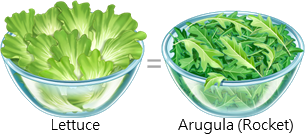| General Information |
-
Nutrients in vegetables
A rich source of water, vitamins and minerals. Most vegetables are natural foods low in fat, salt and sugar and high in dietary fibre. They are good for us.
| Dietary Fibre |
Helps promote bowel's health and prevent constipation; soluble fibre, in particular, can stabilise blood glucose level and help lower blood cholesterol levels |
| β-Carotene |
An antioxidant; helps promote eye health |
| Vitamin B Complex |
One of the most essential nutrients for the body; involves in the metabolism of carbohydrates, fats and proteins |
| Vitamin C |
Helps enhance the absorption of iron from plant foods, assists in the production of collagen, promotes the growth and repair of cells, and speeds up wound healing |
| Vitamin K |
Helps in blood coagulation, prevents excessive blood loss, and keeps the liver healthy |
| Potassium |
Good for the heart; helps stabilise blood pressure |
| Iron |
An essential component in the production of haemoglobin in red blood cells; helps prevent iron deficiency anaemia |
-
Recommended vegetable intake
According to the "Healthy Eating Food Pyramid", the recommended vegetable intake for different age groups is as follows:
| Children aged 2-5 years |
At least 1.5 servings of vegetables |
| Children aged 6-11 years |
At least 2 servings of vegetables |
| Teenagers aged 12 years or above, adults and the elderly |
At least 3 servings of vegetables |
-
"One serving of vegetables" is approximately equivalent to:

One bowl of uncooked salad vegetables (e.g. lettuce, arugula (rocket))

½ bowl of cooked vegetables, melons/squashes/gourds or mushrooms (e.g. flowering Chinese cabbage (Choy Sum), bean sprouts, eggplant, carrot, snow pea, needle mushroom)
Note: One bowl = 250-300 ml
-
What vegetables are not included?
All fresh, canned and frozen vegetables are included in the recommended daily vegetable intake except:
- Preserved vegetables (e.g. salted mustard greens, kimchi, pickles)
- Some starchy root and stem vegetables (e.g. potato, sweet potato)
It is recommended to consume different types of fresh vegetables for more balanced nutrition.
For more vegetable recipes, please visit the "EatSmart Recipes" on the "EatSmart@school.hk" Campaign website, as well as the "Recipes (fruit and vegetables)" on the "EatSmart Restaurant Star+" Campaign website.
|
| Vegetable Categories |
The 5 common categories:
|
Main sources of nutrition information: The Centre for Food Safety, the Government of the Hong Kong Special Administrative Region (HKSAR) and the Nutrient Data Laboratory under the U.S. Department of Agriculture. The information provided above is for reference only. When in doubt, consult a health professional or a dietitian. |
|

